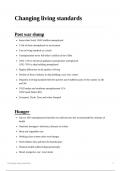Changing living standards
Post war slump
boom short lived; 1920 1million unemployed
1/3rd of those unemployed ex-servicemen
Cuts in living standard as a result
Unemployment never fell below 1million in the 1930s
1932- 12% in electrical appliance manufacturer unemployed
1932- 70% in ship building unemployed
Region differences in the quality of living
Decline of heavy industry in ship building, coal, iron, cotton
Disparity in living standards between poorest and wealthiest parts of the country in 20s
and 30s
1932 london and southeast unemployment 11%
1932 South Wales 40%
Liverpool, Clyde, Tyne and wales slumped
Hunger
Survey 1933 unemployment benefits not sufficient for diet recommended by ministry of
health
Nutrition shortages= deficiency diseases in rickets
Meat and vegetables rare
Working class women often went hungry
Feed children first and then the breadwinner
Womens health suffered disproportionally
Bread, margarine, tea= most meals
Changing living standards 1
, All money spent on food= possessions, clothes, homes became shabby
Poor working class families ends meet= tick from local greengrocers and pawnbrokers in
lending money
Others saw living standards rise: 1933 light industry grew in southeast= consumer boom
As a result: many migrated to london (population rose to 8million)
Consumer boom of the 30s
Consumer boom What was it Key facts to remember Impact
Only middle lasses
could afford | shows
Household electrical 30- 200,000 vacuum
increase in affluence |
appliances: washing cleaner sales/ year 38-
shows increase in living
machines, electric 400,000 vacuum
standards for many
Appliances cookers and vacuum cleaner sales/year.
lives were made easier|
cleaners purchased on 300% increase in sale
Reduced the drudgery
credit. | more houses of electric cookers 30-
of women | efficiency |
were electrified 35
shows growing number
of consumer goods
Advertising created Shows increasing
New chains in: Marks
new chains in which demand for consumer
Market and Spencer and
goods and groceries goods and amount
Sainsburys
sold. being produced.
People spend money on
Living standards
clothes, records,
Teenage culture improved for all, even
enjoying themselves at
the youth.
dances and on day trips
Food from abroad ;
More foods imported prices for basic Wider variety of
and sold; Tinned fruit- foodstuff in tea, sugar, foodstuffs |improved
Food however some believed veg and milk fell diets| Affordable treats
fresh fruit was harmful 20,000 fish and chip even for the lower class
to children shops in Britain; 2p for (widespread impact)
fish, chips 1p
Changing living standards 2





